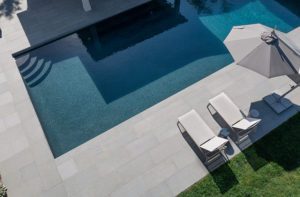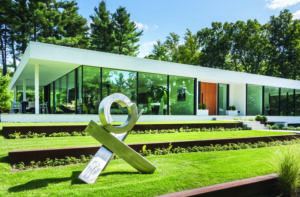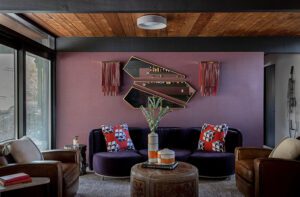Contemporary on Nantucket
September 6, 2018
Tucked in among dunes, beach grasses, and flower-dotted meadowland, a Nantucket home is a spring-to-fall haven for its delighted owners.
Text by Fred Albert Photography by Michael Partenio Produced by Stacy Kunstel

For nearly four decades, a Southern couple summered in a modest cottage on Nantucket’s windswept shore. Nestled alongside grass-covered dunes just a short, sandy stroll from the beach, the place offered the pair a respite from the heat back home and a serene spot to share with their children and friends.
When you’re only in a house for a month or two at a time, it’s easy to ignore problems like cramped, stuffy spaces and remote bathrooms. But with the kids out of the house and retirement upon them, the couple began spending half the year on Nantucket, making such shortcomings increasingly hard to overlook.
The homeowners reached out to Joe Paul and Mark Cutone at Nantucket’s BPC Architecture, to see if the 1970s cape could be renovated to rectify these problems. The architects quickly determined that a remodel might end up costing more than starting from scratch. So, with their clients’ blessing, they began designing a new dwelling for the site.
The couple had always favored traditional homes designed to showcase their collection of French antiques. But with this house the wife was eager to try something a little simpler. “I wanted it to be more contemporary than what we had,” she says. She and her husband, the former owner of an automotive dealership, also wanted to be able to live on a single level, with better climate control, larger bedrooms, more bathrooms, and separate spaces where each could retreat at the end of the day.
Unfortunately, zoning laws dictated that the footprint of the new home couldn’t be any bigger than that of the old one, so the architects had to get creative. To build the 3,570-square-foot house on the allowable footprint of 1,564 square feet, they added a full-height basement to hold a family room and two guest bedrooms and baths. Upstairs, they manipulated wall heights to squeeze in another two guest rooms and baths.
A covered front porch would take up too much real estate, so they recessed the entry to keep it protected from the elements.
Finally, they divided the home into three -asymmetrical volumes, to give it a more random look—like a house that had been added onto over the years. “Whenever we build a new house, we try to embrace that,” Paul says. “It makes for a more unique -experience.”
The taut shingled exterior was stripped of extraneous details, giving it a clean, contemporary look abetted by oversize windows and doors that embrace seductive sweeps of waving grass and serpentine dunes. A landing connecting the upstairs bedrooms is flanked by gridded steel windows that overlook the dining room and recessed entry below. Dormers crown lightwells atop both spaces, flooding them with light and framing peekaboo views of dunes and surf from the second floor.
Builder Todd Burns welcomed this architectural sleight-of-hand. “I’ve done a lot of traditional construction and some historic renovation, so it’s always nice to do something a little different,” he says. In keeping with island tradition, the old house wasn’t demolished, but was given away to another family, who moved it two miles down the road (saving the couple about $20,000 in landfill fees).
The front door of the new house opens into a single space containing the living room, dining area, and kitchen. Sunlight washes over the white plaster walls, white lacquer cabinets, and bleached-oak floors, filling the space with a celestial glow that makes it feel like summer all year long. A slatted screen skirting the staircase admits light and views to the stairwell and introduces a midcentury-modern vibe that’s echoed in the black-and-white furnishings.
“We wanted the architecture and interiors to be a little bit on the quiet side, so as not to compete with the beauty of the natural surroundings,” says Cutone, who nevertheless couldn’t resist inserting a cherry red sofa into the mix. “I just thought, with all the whites, blacks, silvery grays, and chrome, that we needed a punch of color somewhere.”
While the owners love to entertain, dinners are more likely to be barbecues on the deck than sit-down meals inside. The small custom table stationed between the living and kitchen areas can expand to accommodate six in a pinch, but guests can usually be found at the marble-topped island, nursing a cocktail and munching on crackers. (“She doesn’t like to cook,” teases Cutone. “He’ll cook you a great piece of fish. From her, you’re going to get Goldfish.”)
A pass-through at one end of the kitchen frames a fully stocked bar. Since space was at a premium, the architects tucked a washer and dryer underneath the counter in back. “One side stores French wine, and the other side stores Tide,” Cutone quips.
His-and-hers master suites anchor either end of the great room. Each features a peaked shiplap ceiling that falls just short of the walls, creating a shadow line around the perimeter. “We thought it would be kind of fun to make them appear like they’re floating,” says Cutone. There’s a practical benefit, too, since the gap prevents splitting and cracking due to humidity changes.
In keeping with the wife’s mission to simplify the house, much of the furniture is built in. “The rooms aren’t super huge, and by using built-in furniture you maximize efficiency,” explains Cutone, whose custom beds appear to hover over the floor, making the rooms look bigger. While both master bathrooms have a shower, hers includes a freestanding elliptical tub with a breathtaking view of the undulating, flower-dappled dunes. (“I never use the shower,” the wife declares. “Ever.”)
Feathery ornamental grasses caress the sides of the house, dissolving into a meadow dotted with ox-eye daisies, asters and Queen Anne’s lace. “Our goal was to make it look like it’s always been there,” says landscape designer Emily Dutra, whose clients even deemed hydrangeas too fancy for this scrubby, blustery terrain. “It really is a very severe environment,” she adds. “That’s one of the reasons why we use native plants, because nothing else is going to grow there.”
That’s also one of the reasons why her clients head back home to Florida every fall. “I adore this house. I could stay here forever,” proclaims the wife. “I just don’t want to be here in January, February, and March!”
Project Team
Architecture and interior design:
Joe Paul and Mark Cutone, BPC Architecture + Interior Design
Builder: Todd Burns, Todd Burns Building & Restoration
Landscape design: Emily Dutra, Dutra Designs
Share
![NEH-Logo_Black[1] NEH-Logo_Black[1]](https://www.nehomemag.com/wp-content/uploads/2022/08/NEH-Logo_Black1-300x162.jpg)

















You must be logged in to post a comment.